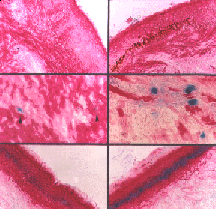Unlocking the Secrets
of Cell Senescence
 Researchers have developed the first technique for
identifying those cells within living organisms that have reached old age.
Researchers have developed the first technique for
identifying those cells within living organisms that have reached old age.
Senescent cells, as they are called, are no longer capable of dividing yet
remain metabolically active. Furthermore, they exhibit changes in form and
function which may lead to age-related changes such as the difference between
the supple skin of a child and the wrinkled skin of the elderly.
Scientists know senescence is an irreversible stage in the life of the cell but
are intent upon learning much more about this mysterious process. Senescence
may be an underlying cause of aging that evolved to prevent the uncontrolled
growth of cells-- what we know as cancer.
The simple, rapid, and
inexpensive test for identifying senescent cells developed by LBL life
scientists Judy Campisi, Goberdhan Dimri, and colleagues at several other
research institutions gives science a powerful new tool for examining
senescence.
Campisi says that because it had not been possible to detect
or study senescent cells in a living animal (in vivo), research until now has
focused on cells grown in culture. Campisi notes that the new technique has
provided the first actual evidence that senescent cells exist in living
organisms, and that they accumulate with age.
The ability to distinguish
senescent cells in vivo allows researchers to take a much closer look at their
suspected role in tumor suppression. "One could say that senescence is the
opposite of cancer," says Campisi. "Some of the same genes that drive
uncontrolled proliferation in cancer seem to be under tight control, or
actually turned off, in senescence."
Scientists now can screen compounds
for senescence-inducing or senescence-delaying activity. These compounds may
have anti-tumor or anti-aging properties. The technique also can be used to
identify genes able to stop cancerous cells from replicating endlessly.
Likewise, it should help in the isolation of genes that trigger premature aging
syndromes.
Campisi said the technique emerged after researchers
discovered that a variety of senesecent human cells including two major types
of skin cells, fibroblasts and keratinocytes, produce or express a particular
form of an enzyme, beta-galactosidase. The senescent form of beta-galactosidase
either is absent or virtually absent in presenescent cells. Based on this
finding, a simple assay was developed that uses a stain to detect the presence
of the enzyme. Old cells -- those that express beta-galactosidase--turn blue.
Campisi said it would be foolish to attempt to completely reverse
senescence in cells because the cessation of growth also prevents cancer. On
the other hand, the ability to manage or alter the changes in function that are
a part of senescence has obvious value.
The biotech industry one day may
attempt to change the phenotypes of senescent cells, for instance as a route to
deal with the skin problems experienced by older people. Again, the new assay
should prove helpful, serving as a first line test to both discover and monitor
the efficacy of therapeutic drugs or genes.
-- Jeffery Kahn
 Researchers have developed the first technique for
identifying those cells within living organisms that have reached old age.
Researchers have developed the first technique for
identifying those cells within living organisms that have reached old age.

 Return to Highlights Table of Contents
Return to Highlights Table of Contents